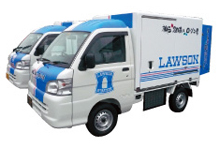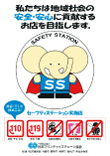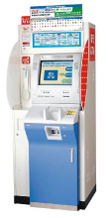niponica is a web magazine that introduces modern Japan to people all over the world.
2013 No.10

To read the e-book you need to have JavaScript enabled in your browser and a free Flash Player plug-in from Adobe Systems Inc. installed.
Quality with a Japanese Flair

Convenience Stores
Practically Everywhere, Always Handy, and Safety Conscious, Too
They offer a great range of goods and services, give consumers peace of mind, and promote safety. Yes, convenience stores in Japan do all that and more, and they now act as vital community hubs, as well.
From a conversation with Kato Naomi
Photos by Enomoto Yoshitsugu
Photos courtesy of the Japan Franchise Association and Lawson, Inc.

Kids playing without a care in the world in front of a convenience store that serves as a shelter in an emergency.

Kato Naomi
A consumer lifestyle consultant, Kato draws on her vast knowledge of the distribution industry as a frequent contributor to magazines specializing in marketing and distribution, and is the author of Konbini to Nihonjin ("Convenience Stores and the Japanese").
Japan's first convenience store is said to have opened in 1974. Since then, they have spread throughout the country under the franchise system, and now, in 2013, there are about 45,000 of them. For the Japanese, especially in urban areas, the convenience store has become part of the modern lifestyle, a place to use any time, almost anywhere. Some people go there not just every day but several times every day. That is because convenience stores in Japan do much more than just stock food products and everyday goods.
They offer ready-to-go bento meals, o-nigiri rice balls, chilled noodles and other foods unique to Japan, and their distribution system includes many deliveries a day. The chains have gathered information on consumer preferences for goods and services, and have used that information to develop spot-on marketing systems. Nowadays the general rule is to operate 24 hours a day. The stores provide products and services people depend on, like coin-operated photocopiers, a system for paying utility bills, an ATM for deposits, withdrawals and bank transfers, and a computer terminal to pay online shopping bills, buy tickets, and get access to a wide range of information. The more users are attracted by the convenience of the stores, the harder the chains have to work to satisfy consumer demand and stay ahead of the competition. As a result, convenience stores in Japan have evolved to the point where they are considered vital to their communities.



Top: Trucks used as Lawson traveling stores in sparsely populated areas. These trucks serve Jinsekikogen-machi in Hiroshima Prefecture.
Above left: The Safety Station (SS) poster indicates that the store is a partner in the local community safety program.
Above right: An ATM is sure to be found in convenience stores. ATMs in Lawson convenience stores are linked to the services of about 60 financial institutions.
Respect earned after disasters
Convenience stores created a very favorable impression after the Great East Japan Earthquake of 2011, and they are now regarded as an essential element of the social fabric. On the same day the earthquake struck, the chains set up emergency support centers, arranged for helicopters to take goods to stores desperate for supplies, sent employees to offer assistance, placed donation boxes on counters, and did much more, all with remarkable speed. They were prepared for this because, after the Great Hanshin Awaji Earthquake of 1995, many chains had signed agreements with local governing bodies, promising to assist people unable to return home after a disaster (for example, letting them use the store toilets and water, and providing them with road information from maps, radio announcements, etc.). The stores were also considering how to respond in other ways in the event of a future disaster. So these preparations were of great use when the disaster actually hit.
Reliable members of the community
The Safety Station (SS) program, promoted by the Japan Franchise Association with local residents and municipal governments, has prompted convenience stores to collaborate within their respective chains and serve as a safe shelter for the community. The Safety Station poster on the store's door tells everyone the outlet has implemented strong anticrime measures, receives police patrols (in some communities), and is ready to be a reliable shelter for women, children and the elderly in a crisis.
In thinly populated places where there are few shops, or where elderly people and others have difficulty getting about for shopping, some convenience stores make deliveries using a traveling sales vehicle. Some stores use energy-saving LED light bulbs indoors to conserve energy and reduce their environmental footprint, and some recycle their waste oil and food scraps.
Japanese convenience stores are increasing their presence overseas, especially in other Asian countries, so much so that some chains have more stores outside Japan than in it. The various systems they have developed in Japan may one day be offered overseas, as well.


